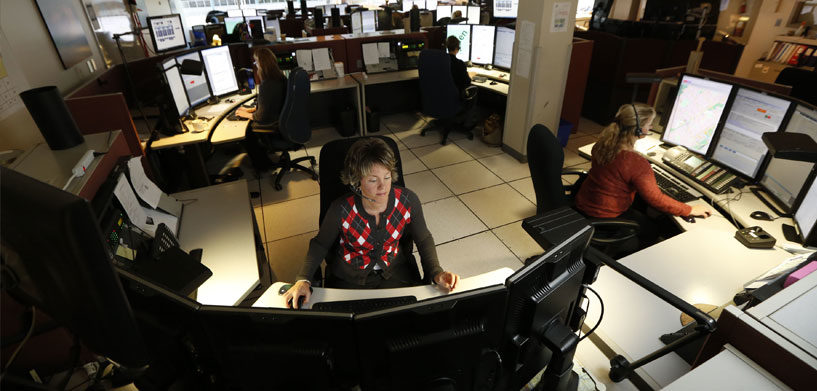A crisis isn’t a scheduled event, which is why public safety agencies and dispatch centers should always have updated plans and contingency policies to guide them.
The worldwide COVID-19 pandemic has pushed many public safety answering points (PSAPs) to the brink of operational effectiveness. During a chaotic event, call-takers not only have to respond to the ongoing crisis, but also answer unrelated calls about other emergency situations and information requests.
Whether a PSAP is in the middle of a crisis, or if leaders simply want to get ahead of the next one, there are four key strategies that can help reduce the number of incoming calls.
1. Open new communication channels
During a time of disaster, not all calls will be related to the specific event. Members of the public will experience other health-related emergencies, while some anxious citizens will want to know the latest information.
Depending on the region and technical capability, leaders may want to consider establishing a secondary PSAP and alternate number for less serious emergencies and/or information requests. If calls into the secondary PSAP prove to be more serious, they can be transferred to the primary call center for faster response.
Overcome with a barrage of calls during the height of the COVID-19 pandemic, the 112 PSAP in the region of Lombardy, Italy, established two additional emergency call centers within a 12-hour period. Doing so took strain off call-takers in the primary PSAP, which allowed them to focus on time-sensitive calls for service. Agencies should consider an alternate phone number as part of contingency planning, as implementation can sometimes take weeks or months.
If agencies can’t quickly establish an information hotline, there are other ways to ensure open, honest, and quick communication with the public:
- A website or mobile app
- Social media
- Public warning systems
- Community message boards
- Text message alerts
- Media outlets, including television, radio, and print
A steady flow of relevant, timely information calms the public and reduces anxiety during a crisis. A reliance on multiple information channels, from high-tech capabilities to traditional media, will reduce the number of nonemergency calls into a PSAP.
2. Reduce stress through planning
During a crisis, too much stress can be detrimental because it can affect decision-making, efficiency, and response. It can often lead to burnout and high turnover rates. Ensuring PSAPs are adequately staffed will reduce the stress on call-takers and dispatchers on the front lines.
Call-takers who experience an overwhelming call volume during a crisis might ask for additional help, which is usually easier said than done. Even if more personnel are hired, it could take weeks to train them on processes and equipment.
In the short term, leaders may have to rearrange schedules of existing call-takers to cover shifts properly. If dispatchers are unable to work because illness or family obligations, PSAP leaders will have to get creative. In Finland, for example, students working at the Emergency Services College were hired to support ancillary duties, such as testing automatic fire alarm devices.
In other countries, employees who met call-taking requirements were pressed into services, and older call-takers were called out of retirement to meet demand. The good news for agencies is that, in the world of public safety, those who can heed the call often will.
3. Promote flexibility
Once a PSAP has the appropriate call-taking capacity, call-takers will have to quickly adapt to the wide range of scenarios that occur during a crisis ̶ from life-threatening to trivial. This means being flexible and agile as situations change.
Whether part of contingency planning or during a public emergency, agency leaders should establish priorities for service calls. To that end, they should update computer-aided dispatch (CAD) workflows to ensure call-takers ask relevant questions to determine the importance of the call.
For calls in which seconds matter, call-takers and/or dispatchers can enter details into the CAD system and quickly disseminate it to units in the field so they have the latest information. Asking the appropriate questions can also determine if the caller should be transferred to an information hotline, which frees up the call-taker to answer legitimate emergency calls.
4. Consider remote work
Not every PSAP is flexible enough to allow dispatchers to work remotely, but it could become necessary, depending on the severity of the crisis. For example, the COVID-19 pandemic led to about 10% of Ireland’s dispatchers working from home.
Provided call-takers and dispatchers have the five necessities – a phone, a computer, a headset with microphone, reliable Wi-Fi network, and a router with the latest firmware – they can work from anywhere and thrive. Working from a remote location won’t reduce the number of calls from the public, however, which is why ensuring workflow flexibility is crucial.
If call-takers are forced to work from home, agency leaders should ensure remote PSAP operations meet stringent security standards, whether information is shared via web browser or virtual private network (VPN). Remote PSAPs should also be compliant with any local, state, and federal crime database security guidelines, like the FBI’s Criminal Justice Information Services (CJIS) in the United States.
Conclusion
No crisis is ideal, but agencies should go above and beyond to:
- Be open with the public
- Ensure proper staffing levels
- Be flexible
- Plan for remote work
Taking these steps will not only reduce stress on PSAP staff, but it will also help personnel manage the significant increase in calls for service that occurs in a crisis. And with proper contingency planning, agency leaders will be in a better operational position when the next crisis hits.
Next Steps
To learn more about leading a public safety organization through tough times, listen to our latest podcast.















